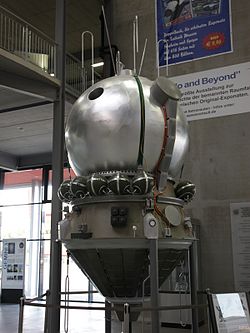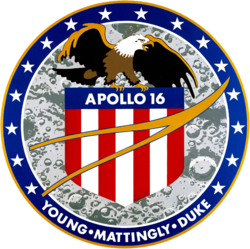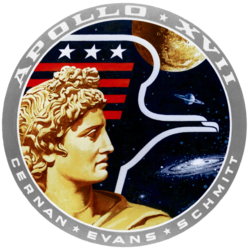Apollo 16
| Apollo 16 | |||
 | |||
| Statistik för uppdraget | |||
|---|---|---|---|
| Uppdrag | Apollo 16 | ||
| NSSDC-ID | Kommandomodul: 1972-031A[1] Månlandare: 1972-031C[2] | ||
| Kommandomodul | Casper | ||
| Månlandare | Orion | ||
| Anrop | Casper Kommandomodul Orion Månlandare | ||
| Varaktighet | 11 dagar, 1 timme, 51 minuter, 5 sekunder | ||
| Uppskjutning | |||
| Raket | Saturn V | ||
| Uppskjutningsramp | Kennedy Space Center LC-39 A | ||
| Uppskjutning | 16 april 1972 17:54:00 UTC | ||
| Landning | |||
| Landning | 27 april 1972 19:45:05 UTC | ||
| Månen | |||
| Månlandning | 21 april 1972 02:23:35 UTC | ||
| Månuppskjutning | 24 april 1972 01:25:47 UTC | ||
| Månprover, vikt | 95,71 kg | ||
| Antal månpromenader | 3 st | ||
| Månpromenader, längd | 20 timmar, 14 minuter, 14 sekunder | ||
| Dockning | |||
| Dockning | 16 april 1972 21:15:53 UTC | ||
| Ur dockning | 20 april 1972 18:07:31 UTC | ||
| Andra dockningen | 24 april 1972 03:35:18 UTC | ||
| Andra ur dockning | 24 april 1972 20:54:12 UTC | ||
| Rymdpromenad | |||
| Antal rymdpromenader | 1 st | ||
| Total tid för rymdpromenad | 1 timme, 23 minuter, 42 sekunder | ||
| Besättning | |||
| Befälhavare | John W. Young | ||
| Pilot | Thomas K. Mattingly (kommandomodulen) Charles M. Duke (månlandaren) | ||
 | |||
| Kronologi | |||
| |||
Apollo 16 var den 16–27 april 1972 den tionde bemannade rymdfärden inom Apolloprogrammet och den femte landningen på månen.

Besättning:
- John W. Young, befälhavare
- Thomas K. Mattingly, pilot för kommandomodulen
- Charles M. Duke, pilot för månlandaren
Väckningar
Under Geminiprogrammet började NASA spela musik för besättningar och sedan Apollo 15 hade man varje "morgon" väckt besättningen med ett särskilt musikstycke, utvalt antingen för en enskild astronaut eller för de förhållanden som rådde.
Referenser
- ^ ”NASA Space Science Data Coordinated Archive” (på engelska). NASA. https://nssdc.gsfc.nasa.gov/nmc/spacecraft/display.action?id=1972-031A. Läst 27 mars 2020.
- ^ ”NASA Space Science Data Coordinated Archive” (på engelska). NASA. https://nssdc.gsfc.nasa.gov/nmc/spacecraft/display.action?id=1972-031C. Läst 27 mars 2020.
Externa länkar
 Wikimedia Commons har media som rör Apollo 16.
Wikimedia Commons har media som rör Apollo 16.
| |||||||||||||||||||||||||||||||||||||||||||
| |||||||||||||||||||||||||||||||||
Media som används på denna webbplats
Logo of Apollo 15
This is the insignia designed for the Apollo 15 lunar landing mission. The circular design features the colors red, white and blue. On the outer portion of the patch a narrow band of blue and a narrow band of red encircle a wider band of white. The large disc in the center of the emblem has red, white and blue symbols of flight, superimposed over an artist's concept of the Apollo 15 Hadley-Apennine landing site of gray tone. The surnames of the three names are centered in the white band at the bottom of the insignia. The Apollo 15 prime crew men are David R. Scott, commander; Alfred M. Worden, command module pilot; and James B. Irwin, lunar module pilot.
The prime crew of the Apollo 16 lunar landing mission. From left to right: Thomas K. Mattingly II, Command Module pilot; John W. Young, Commander; and Charles M. Duke Jr., Lunar Module pilot.
Författare/Upphovsman: Pascal (Flickr user: pasukaru76), Licens: CC0
Vostok spacecraft replica at the Technik Museum Speyer, Germany.
Apollo 16 mission logo
The Apollo 16 crew patch is dominated by an eagle perched atop a red, white and blue shield a superimposed on a lunar scene, surrounded by a blue circle of 16 stars with the crew's surnames completing the bottom are of the circle. Across the face of the shield is a gold symbol of flight outlined in blue, similar to that on the National Aeronautics and Space Administration (NASA) agency seal and insignia. The design was created by NASA artist Barbara A Matelski[1][2] from ideas submitted by the three crew members: astronauts John W. Young, commander; Thomas K. Mattingly II, command module pilot; and Charles M. Duke Jr., lunar module pilot.
This is the official emblem of the Apollo 17 lunar landing mission which was flown by astronauts Eugene A. Cernan, Ronald E. Evans and Harrison H. Schmitt.
- The insignia is dominated by the image of Apollo, the Greek sun god. Suspended in space behind the head of Apollo is an American eagle of contemporary design, the red bars of the eagle's wing represent the bars in the United States flag; the three white stars symbolize the three astronaut crewmen. The background is deep blue space and within it are the moon, the planet Saturn and a spiral galaxy or nebula. The moon is partially overlaid by the eagle's wing suggesting that this is a celestial body that man has visited and in that sense conquered. The thrust of the eagle and the gaze of Apollo to the right and toward Saturn and the galaxy is meant to imply that man's goals in space will someday include the planets and perhaps the stars. The colors of the emblem are red, white and blue, the colors of our flag; with the addition of gold, to symbolize the golden age of space flight that will begin with this Apollo 17 lunar landing. The Apollo image used in this emblem was the famous Apollo of Belvedere sculpture now in the Vatican Gallery in Rome. This emblem was designed by artist Robert T. McCall in collaboration with the astronauts.
John W. Young on the Moon during Apollo 16 mission jumping about 42 Centimeters high. Charles M. Duke Jr. took this picture. The LM Orion is on the left. April 21, 1972











